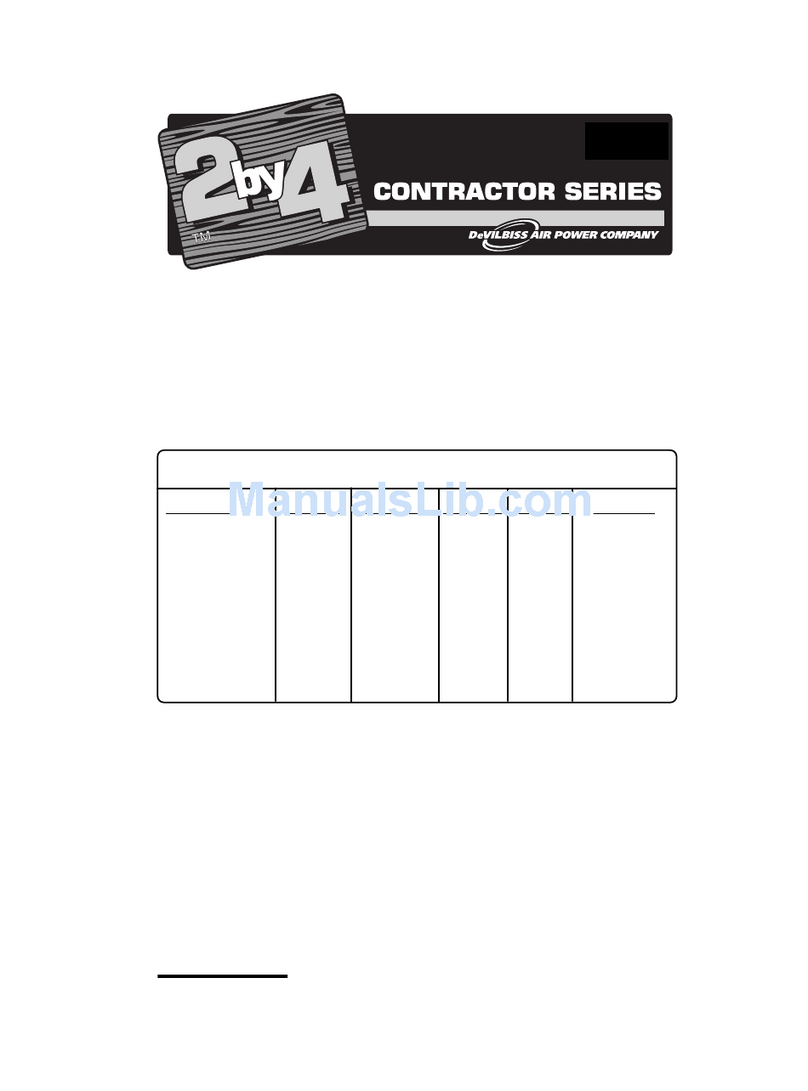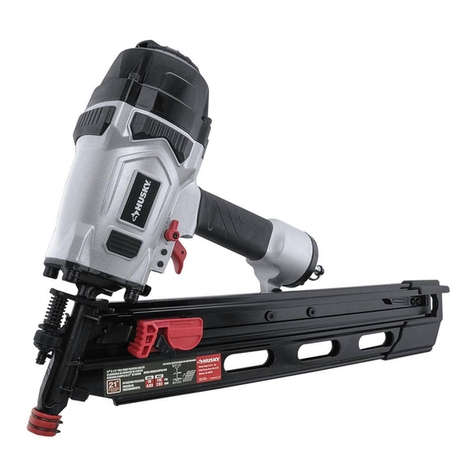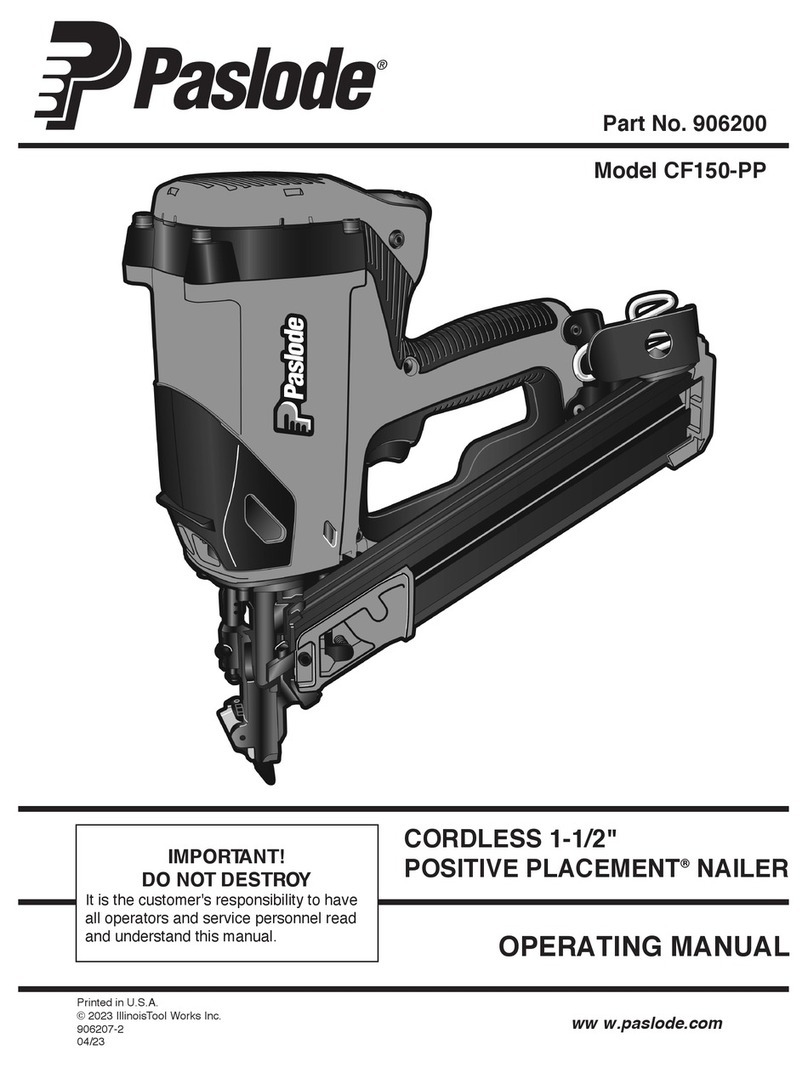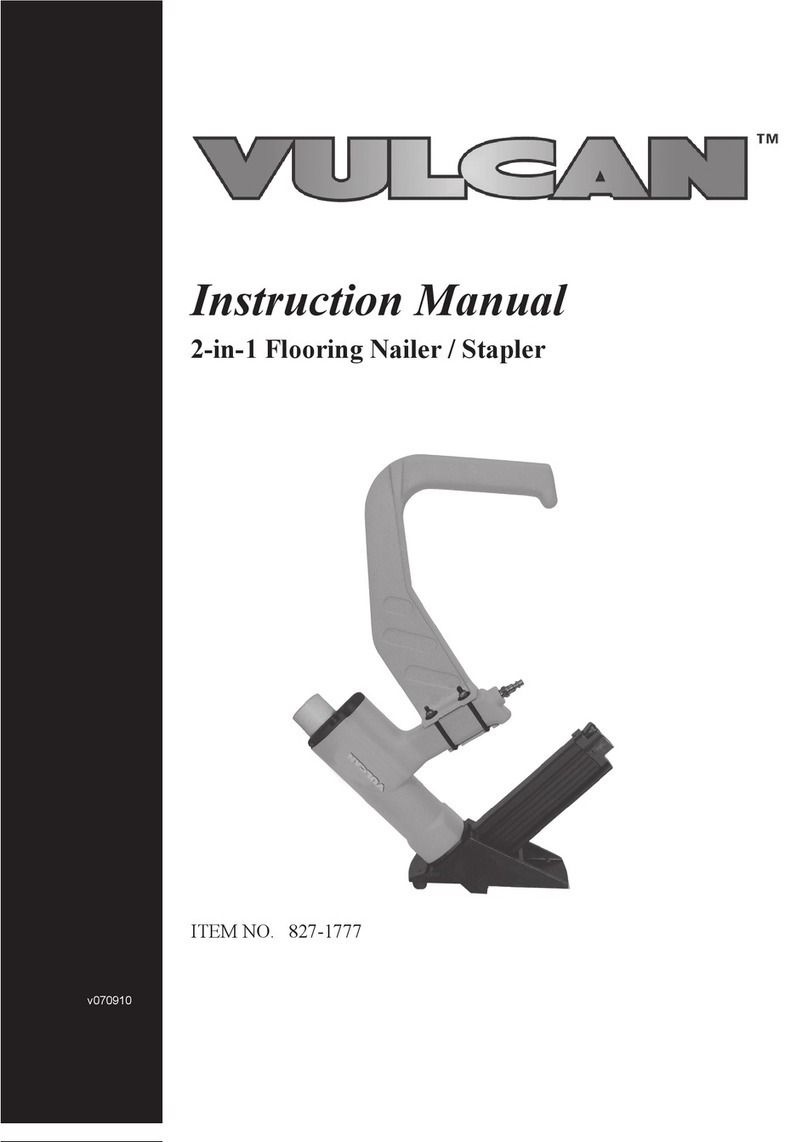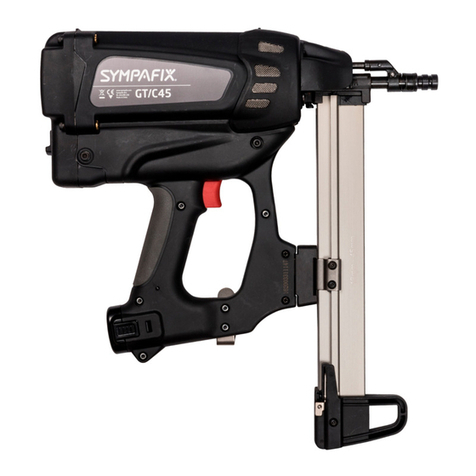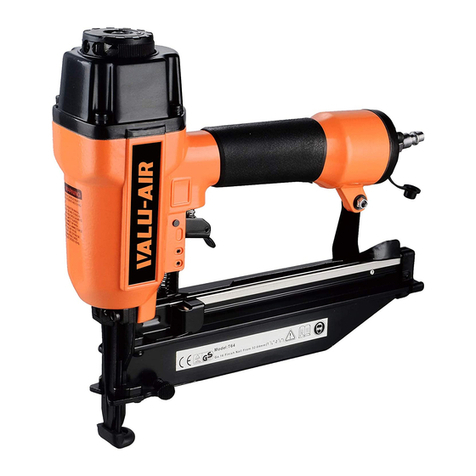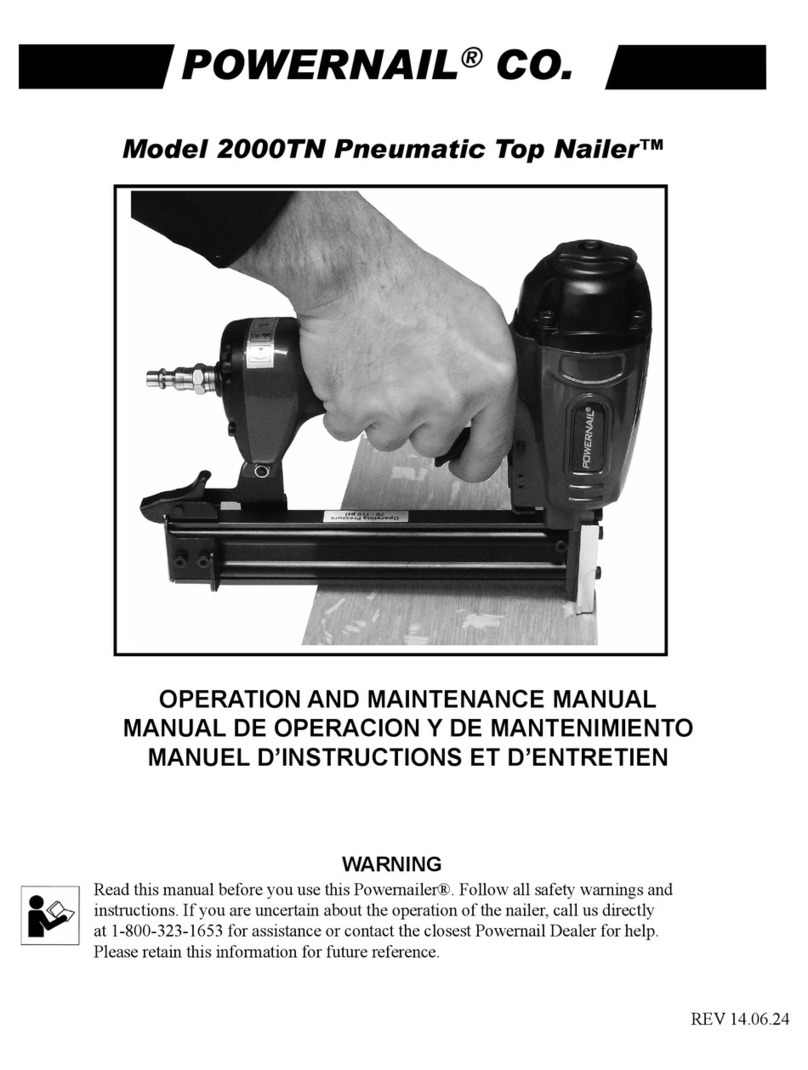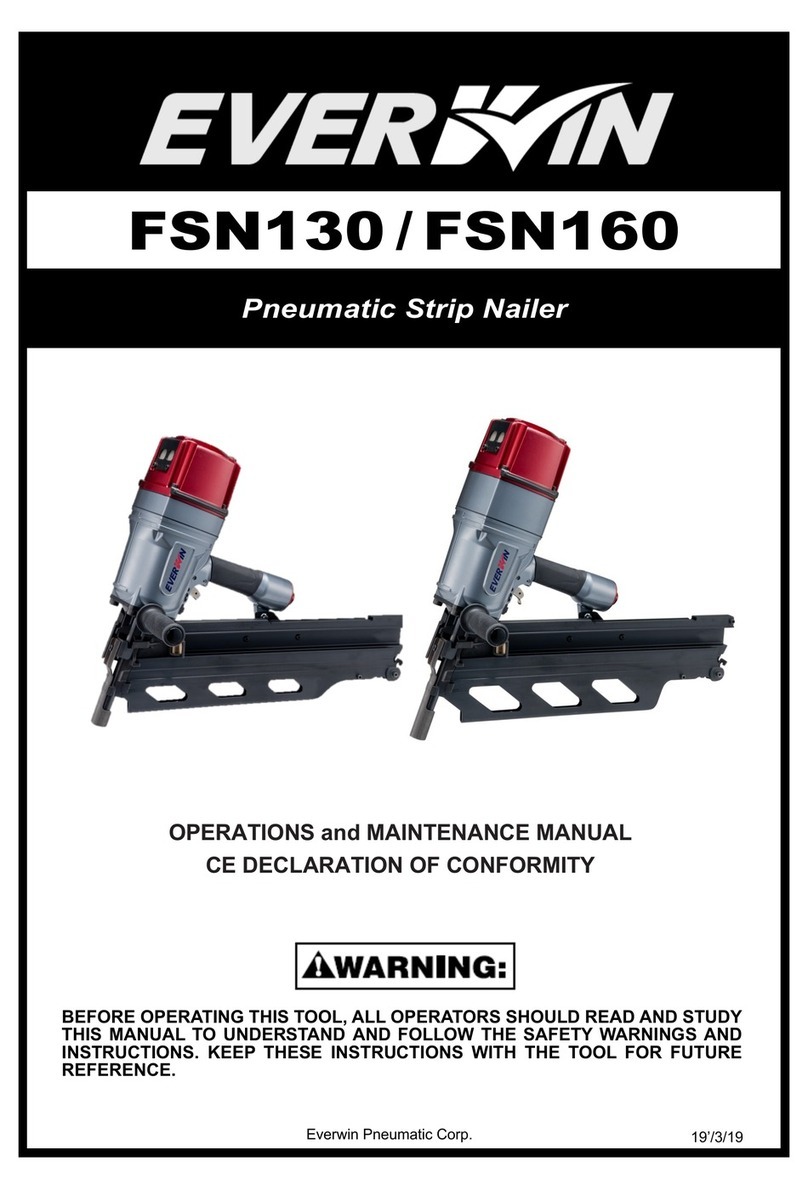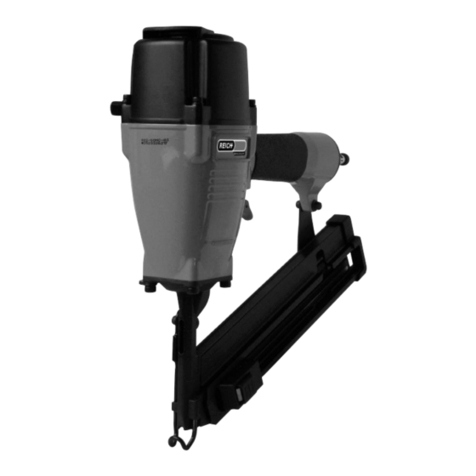DeVillbiss Air Power Company AFN5 User manual

Operation, Maintenance, and Parts Manual for AFN5
ANGLE FINISHING NAILER
DeVilbiss Air Power Company • 213 Industrial Drive • Jackson, TN 38301-9615
MGP-AFN5-1A 2/20/98
This manual contains information that is important for you to know and under-
stand. This information relates to protecting YOUR SAFETY and PREVENTING
EQUIPMENT PROBLEMS. PLEASE READ THIS MANUAL.
STEEL DRIVER SERIES
Specifications
MODEL.............................................................. AFN5
AIR INLET ......................................................... 1/4" NPT
WEIGHT ............................................................ 5 lbs.
LENGTH ............................................................ 13"
HEIGHT ............................................................. 10"
MAXIMUM PRESSURE ..................................... 125 PSI
PRESSURE RANGE .......................................... 75-100 PSI
FASTENER LENGTHS ....................................... 1" - 2 1/2"
MAGAZINE CAPACITY...................................... 100 Nails
SCFM REQUIRED @ 90 PSI ............................. Every 10 Fasteners
Delivered Per Minute
Requires .93 SCFM
MINIMUM COMPRESSOR HP
REQUIRED TO OPERATE ................................. 3/4 HP
(TANK MOUNTED)

2
TABLE OF CONTENTS
PAGE
Tool Specifications ............................................................................. Front Cover
Table of Contents ................................................................................ 2
Limited Warranty ................................................................................. 3
Safety Guidelines ................................................................................ 4
Warning Chart ..................................................................................... 4-6
Lubrication and Maintenance .............................................................. 7-8
Recommended Hook-up ..................................................................... 8
Contact Trip Safety Mechanism ........................................................... 9
A. Operating A Contact Trip Tool
B. Checking The Operation Of Contact Trip Safety Mechanism
Loading The Tool ................................................................................ 10
Operating the Tool............................................................................... 10-11
Clearing A Jam From The Tool............................................................ 11
Trouble Shooting Guide ...................................................................... 12
Exploded View .................................................................................... 13
Parts List ............................................................................................ 14
Parts Kits ............................................................................................ 14
Fasteners............................................................................................ 15
Toll-Free 800 Number ......................................................................... Back Cover

3
LIMITED WARRANTY
ONE YEAR FROM DATE OF PURCHASE
All merchandise manufactured by DeVilbiss Air Power Company/ExCell Manufacturing is warranted to be free of
defects in workmanship and material which occur during the first year from the date of purchase by the original
purchaser (initial user). Products covered under this warranty include: air compressors, *air tools, accessories,
service parts, pressure washers, and generators used in consumer applications (i.e., personal residential
household usage only).
Air compressors, *air tools, accessories, service parts, pressure washers, and generators used in commercial
applications (income producing) are covered by a 90 day warranty.
DeVilbiss Air Power/ExCell Manufacturing will repair or replace, at DeVilbiss/ExCell’s option, products or
components which have failed within the warranty period. Repair or replacement, and service calls on 60 and 80
gallon air compressors, will be handled by Authorized Warranty Service Centers and will be scheduled and
serviced according to the normal work flow and business hours at the service center location, and depending on
the availability of replacement parts.
All decisions of DeVilbiss Air Power Company/ExCell Manufacturing with regard to this policy shall be final.
This warranty gives you specific legal rights, and you may also have other rights which vary from state to state.
Form: SP-100-F - 10/28/97
THIS WARRANTY DOES NOT COVER:
RESPONSIBILITY OF ORIGINAL PURCHASER (Initial User):
o
Retain original cash register sales receipt as proof of purchase for warranty work.
o
Use reasonable care in the operation and maintenance of the product as described in the Owners Manual(s).
o
Deliver or ship the product to the nearest DeVilbiss Air Power/ExCell Manufacturing Authorized Warranty
Service Center. Freight costs, if any, must be paid by the purchaser.
o
Air compressors with 60 and 80 gallon tanks only will be inspected at the site of installation. Contact the
nearest Authorized Warranty Service Center, that provides on-site service calls, for service call arrangement.
o
If the purchaser does not receive satisfactory results from the Authorized Warranty Service Center, the
purchaser should contact DeVilbiss Air Power Company/ExCell Manufacturing.
o
Merchandise sold as reconditioned, floor models and/or display models. Any damaged or incomplete equipment
sold "as is".
o
Merchandise used as "rental" equipment.
o
Merchandise that has become inoperative because of ordinary wear, misuse, freeze damage, use of improper
chemicals, negligence, accident, improper and/or unauthorized repair or alterations including failure to operate
the product in accordance with the instructions provided in the Owners Manual (s) supplied with the product.
*Air Tools: O-Rings and driver blades are considered ordinary wear parts, therefore, they are warranted for a
period of 45 days from the date of purchase.
o
An air compressor that pumps air more than 50% during a one hour period is considered misuse because
the air compressor is undersized for the required air demand. Maximum compressor pumping time per hour is
30 minutes.
o
Merchandise sold by DeVilbiss Air Power/ExCell Manufacturing which has been manufactured by and identified
as the product of another company. The product manufacturer's warranty will apply.
o
Repair and transportation costs of merchandise determined not to be defective.
o
Cost associated with assembly, required oil, adjustments or other installation and start-up cost.
o
ANYINCIDENTAL,INDIRECTOR CONSEQUENTIALLOSS, DAMAGE, OR EXPENSETHAT MAYRESULT
FROM ANY DEFECT, FAILURE OR MALFUNCTION OF THE PRODUCT. Some states do not allow the
exclusion or limitation of incidental or consequential damages, so the above limitation or exclusion may not apply
to you.
o
IMPLIEDWARRANTIES,INCLUDING THOSEOFMERCHANTABILITY ANDFITNESSFOR APARTICULAR
PURPOSE, ARE LIMITED TO ONE YEAR FROM THE DATE OF ORIGINAL PURCHASE. Some states do not
allow limitations on how long an implied warranty lasts, so the above limitations may not apply to you.
213 Industrial Drive • Jackson, TN 38301-9615
Telephone: 1-800-888-2468 , Ext. 2
FAX: 1-800-888-9036

4
HAZARD TO LOOK FOR
Compressed Gas
Excessive Operating Pressure
Unsuitable Cleaning Solvents
WHAT COULD HAPPEN
Oxygen will react with oil in tool causing
an explosion. Flammable gases will ig-
nite from sparking and cause the tool to
explode.
THE TOOL COULD EXPLODE!
Flammable vapors in the tool will ignite
by a spark and could cause the tool to
explode!
HOW TO PREVENT IT
Do not use any type of flammable
gases or oxygen as a power source
for the tool.
Use only filtered, lubricated, regu-
lated compressed air .
Operate tool with clean dry air, regu-
lated to 100 psi pressure maximum.
Never use gasoline or other flam-
mable liquids to clean the tool.
Risk of explosion.
SAFETY GUIDELINES - DEFINITIONS
IMPORTANT SAFETY INFORMATION - A
HAZARD THAT MIGHT CAUSE SERIOUS
INJURY OR LOSS OF LIFE.
Information that you should pay special
attention to.
URGENT SAFETY INFORMATION - A HAZARD
THAT WILL CAUSE SERIOUS INJURY OR LOSS
OF LIFE.
This manual contains informa-
tion that is important for you to
know and understand. This infor-
mation relates to protecting YOUR
SAFETYandPREVENTINGEQUIP-
MENT PROBLEMS. To help you
recognize this information, we use
symbols to the right. Please read
the manual and pay attention to
these sections.
Information for preventing damage to
equipment.
IMPORTANT SAFETY INSTRUCTIONS
• SAVE THESE INSTRUCTIONS •
IMPROPER OPERATION OR MAINTENANCE OF THIS PRODUCT COULD RESULT
IN SERIOUS INJURY AND PROPERTY DAMAGE. READ AND UNDERSTAND ALL
WARNINGS AND OPERATING INSTRUCTIONS BEFORE USING THIS EQUIPMENT.

5
SAFETY GUIDELINES
Read these warnings carefully. Failure to follow
warnings will result in severe injury or death!
DANGER
Risk of head injury.
WHAT COULD HAPPEN
Metal fragments, fasteners, or other ma-
terial could be projected against head or
into eyes. Continued exposure to an
operating tool can result in permanent
hearing damage.
HOW TO PREVENT IT
Always wear ANSI approved Z87 safety
glasses, Z89.1 head protection and
S3.19 hearing protection.
HAZARD TO LOOK FOR
Injury to eyes, head and hearing
Risk of puncture injury.
WHAT COULD HAPPEN
A fastener could accidentally be driven if
the contact trip safety mechanism is not
working.
Death or a serious puncture could occur
if the contact trip bumps something or
someone while holding the tool with the
trigger depressed.
Damage to the tool or to the contact trip
safety mechanism can result from im-
proper handling, resulting in unsafe op-
eration.
HOW TO PREVENT IT
Do not remove, modify or bypass
contact safety device.
Do not use the tool if any shields or
guards are removed or altered.
Always check contact trip safety
mechanism of the tool before each use.
Never carry the tool by the hose or pull
the hose to move the tool or a compres-
sor. Keep hoses away from heat, oil and
sharp edges. Replace any damaged,
weak or worn hoses.
HAZARD TO LOOK FOR
Unsafe operation and improper
handling of tool
CONTINUED NEXT PAGE

6
WHAT COULD HAPPEN
Accidental discharge of a fastener can
occur.
HOW TO PREVENT IT
Hold tool by the handle and keep trigger
and contact trip safety mechanism from
contacting objects or parts of the body
when connecting or disconnecting air
supply.
Disconnect air hose before loading fas-
teners, removing a jammed fastener,
servicing the tool, or moving the tool to
another work area.
Do not use a check valve or any other
fitting which allows air to remain in the
tool.
HAZARD TO LOOK FOR
Connecting and Disconnecting
Air Hose
Risk of puncture injury.
Risk from flying objects.
WHAT COULD HAPPEN
Fasteners could ricochet or be propelled
causing injury to self or others.
When working along edges or next to
voids in work surface, the contact trip
safety mechanism could be depressed
and allow the tool to discharge a fastener
into the air or through thin work materials.
HOW TO PREVENT ITHAZARD TO LOOK FOR
Injury to self or others in the work
area.
Pay attention to others in the work area to
assure that they are protected from pos-
sible accidental discharge of fastener, or
projected fragments of work material, fas-
teners, etc.
Provide ANSI approved Z87 safety
glasses, Z89.1 head protection, and S3.19
hearing protection to self and others in
the work area.
Never point discharge of tool at self or
others.
Do not pull trigger unless tool contact
safety device is against work surface.
Never attempt to drive fasteners into hard
surfaces such as steel, concrete, or tile.
Take care to avoid driving a fastener on
top of another fastener.
Before operating tool, be certain that
work surfaces are strong enough and
thick enough to contain entire fastener.
Position tool carefully so that fasteners
will be delivered to the proper location.
SAFETY GUIDELINES

7
Many air tool users find it convenient to use a Filter to
remove liquid and solid impurities which can rust or
"gum up" internal parts of the tool. A Filter also
increases the efficiency and useful life of the tool.
Drain water from the filter periodically. (See Figure 3)
Do not store the tool in cold weather. Frost or ice can
form on the operating valves or mechanisms and the
tool may not operate correctly.
Figure 1
Figure 2
Figure 3
In cold weather operation (near or below freezing), DO
NOT USE a permanent antifreeze such as ethylene
glycol for a cold weather lubricant. This type of anitfreeze
will damage o-rings and seals of the tool.
NOTE
Many air tool users find it convenient to use an Oiler
to help provide oil circulation through tool. An Oiler
also increases the efficiency and useful life of the tool.
An oiler is recommended for tools that receive heavy
or constant use. Check oil level in the oiler daily.
(See Figure 2)
LUBRICATION AND MAINTENANCE
NOTE
Proper lubrication is the owner's responsibility.
Failure to lubricate the tool properly will dramatically
shorten the life of the tool and void your warranty.
NOTE
Excessive oil will damage o-rings and seal of
tool. If in-line oiler is used, manual lubrica-
tion through the air inlet is not required on a
daily basis.
Regulator
Oiler
Regulator
Filter
1. Disconnect the air supply from the tool before
manually lubricating.
2. Turn the tool so the air inlet is facing up and put one
dropof Air Tool Oil, high speed spindle oil, such as
Unocal RX22, or 3-in-1 oil into the air inlet. DO NOT
USE detergent oil or additives. Operate the tool
briefly after adding oil. (See Figure 1)
DO NOT OVER LUBRICATE AIR TOOL.
3. Wipe off excessive oil at the exhaust.
Your tool requires lubrication before you use it for
the first time and before and after each additional
use. If an Oiler is used, manual lubrication through the
air inlet is not required on a daily basis. Lubrication
prevents wear and prevents rust from forming.

8
Always connect the Female Quick Coupler to the air
hose. Never connect the Female Quick Coupler to the
tool.
LUBRICATION AND MAINTENANCE
The air compressor must be able to maintain a minimum of
75 PSI when the tool is being used. An inadequate air
supply can cause a loss of power or inconsistent operation.
Never carry the tool by the hose or pull the hose to
move the tool or a compressor. Keep hoses away
from heat, oil, and sharp edges. Replace any dam-
aged, weak or worn hoses.
Use a Pressure Regulator on your compressor with an
operating pressure of 0-125 PSI. A Pressure Regulator
is required to control the operating pressure of your tool.
Do not use a check valve or any other fittings which will
allow air to remain in the tool. Serious personal injury
could occur.
Do not use any type of flammable gases or oxygen as a
power source for the tool. Use filtered, lubricated, regu-
lated compressed air only. Use of compressed gas in-
stead of compressed air may cause the tool to explode
and cause death or serious personal injury.
AIR
COMPRESSOR
NAILER
MALE
QUICK
CONNECTOR
(Supplied with Tool)
FEMALE
QUICK
COUPLER
MALE
QUICK
CONNECTOR
OILER FILTER
FEMALE
QUICK
COUPLER
AIR
HOSE
(3/8" I.D.) REGULATOR
NOTE
For better performance, install a 3/8" Quick Con-
nector (1/4" NPT threads) with an inside diameter
of .315 (8 mm) on your Tool and a 3/8" Quick Coupler
on the air hose. A minimum of 3/8" I.D. air hose with
a rated working pressure of 150 PSI or above should
be used.
RECOMMENDED HOOK-UP
The following illustration shows the proper hook-up which will help prolong the life of the Tool.

9
Never keep the trigger pulled on contact trip tools
when carrying or holding the tool. Death or a serious
puncture wound could occur if the contact trip bumps
something or someone.
Keep your hands and body away from the fastener
discharge area of the tool. Serious personal injury
could occur.
Do not hold the tool against the work surface with
extra force. Allow the tool to drive the fastener.
Do not use the contact trip mechanism as a means of
discharging a fastener because:
1. It could result in personal injury
2. It could result in an accidental release of a
fastener.
3. It may cause damage to the mechanism.
4. It could result in improper placement of fastener
in work piece.
CONTACT TRIP
Your ANF5 Angle Finish Nailer is a contact trip operated
tool. When the operator depresses the contact trip safety
mechanism against the work surface and then pulls the
trigger, a fastener will be driven.
OPERATING A CONTACT TRIP TOOL:
1. Requires finger to be off the trigger and the nose of
the tool to be placed on the work surface.
2. The contact trip safety mechanism is then depressed
against the work surface and the trigger is pulled to
drive a fastener.
3. The trigger is released after each fastener is driven.
4. Move the tool to the next desired fastener location
and repeat the procedure above.
Check the operation of the contact trip safety
mechanism often. Do not use the tool if the
contact trip safety mechanism is not working
correctly.
CHECKING THE OPERATION OF
CONTACT TRIP SAFETY MECHANISM
1. Disconnect the air supply from the tool.
2. Remove all fasteners from the magazine.
3. Make sure the trigger and contact trip safety mechanism
move up and down without any sticking or binding.
4. Reconnect air supply to the tool.
5. Depress the contact trip safety mechanism against the
work surface without pulling the trigger. The tool must
not cycle. Do not use the tool if a cycle occurs.
6. Hold the tool clear of the work surface. The contact
trip safety mechanism should return to its original
down position. Pull the trigger. The tool must not
cycle. Do not use the tool if a cycle occurs.
7. Depress the contact trip safety mechanism against
the work surface. Pull the trigger. The tool must
cycle.
CONTACT TRIP SAFETY MECHANISM
Make sure not to pull the trigger or depress the
contact trip safety mechanism when connecting
the tool to an air compressor. Serious personal
injury can occur if the tool cycles.

10
Disconnect tool from air supply before adjusting,
clearing jams, servicing, relocating or during non-
operation.
Never place your hand or any part of your body in the
fastener discharge area of the tool when air supply is
connected to the tool. Serious personal injury may
occur.
LOADING THE TOOL
Loading the Tool
1. Disconnect air hose.
2. Pull feeder back into "locked" position. (See Step 2)
3. Insert a stick of fasteners into the magazine. Make
sure the pointed ends of the fasteners are loaded with
the points downward. Also make sure fasteners are not
dirty or damaged. Use DeVilbiss fasteners or equivalent
for proper fastener performance. (See Step 3)
4. Push release button and slide feeder shoe forward.
(See Step 4)
Handle the tool carefully. Respect the tool as a
working implement and always assume the tool con-
tains fasteners:
a. Never use the tool as a toy and engage in horse-
play.
b. Never aim or point the tool at anyone. The tool
may contain fasteners.
c. Always keep people and animals at a safe
distance from the work area in case of
accidental discharge of fasteners.
d. Never pull the trigger unless the nose of the tool
is against the work surface.
e. Do not pull the trigger or depress the contact trip
when loading the tool.
Protect your eyes and ears. Wear Z87 safety glasses
with side shields. Wear hearing protection. Employ-
ers and users are responsible for ensuring the user or
anyone near the tool wear this safety protection.
READ THIS MANUAL AND UNDERSTAND ALL
SAFETY WARNINGS AND INSTRUCTIONS BEFORE
OPERATING TOOL.
NOTE
Use DeVilbiss Air Power fasteners or equivalent for
proper performance of tool. See page 15 for fastener
information.
Step 3 Step 4
Step 2
OPERATING THE TOOL
Disconnect tool from air compressor before adjust-
ing, clearing jams, servicing, relocating and during
non-operation.
NOTE
Check and replace any damaged or worn compo-
nents on the tool. The safety warning labels on the
tool must also be replaced if they are not legible.

11
OPERATING THE TOOL
Disconnect tool from air compressor before adjust-
ing, clearing jams, servicing, relocating and during
non-operation.
FASTENER JAMMED IN FASTENER DISCHARGE AREA:
1. Disconnect tool from air hose. (Step 1)
2. Pull feeder shoe back into "locked" position and
remove nails. (Step 2)
3. Unlatch and open door. (Step 3)
4. Grab jammed fastener with pilers and remove:
close latch door. (Step 4)
5. Reload fasteners into magazine and unlock feeder
shoe.
FASTENER JAM INSIDE MAGAZINE:
1. Disconnect tool from air hose.
2. Pull feeder shoe back into "locked" position.
3. Remove jammed fasteners.
4. Load good fasteners and unlock feeder shoe.
Step 3
Step 2
Step 1
CLEARING A JAM FROM THE TOOL
1. Add one drop of Air Tool Oil, high speed spindle oil,
such as Unocal RX22, or 3-in1 oil into the air inlet.
2. Connect the Tool to the air supply.
3. Regulate the air pressure to obtain a minimum of 75 PSI
at the tool.
4. Test for proper fastener penetration by driving fasteners
into a sample piece of wood. If the fasteners do not
achieve the desired penetration, adjust the air pressure
to a lower or higher setting until the desired penetration
is achieved. Do not exceed 100 PSI at the tool.
Step 4

12
TROUBLESHOOTING GUIDE
Stop using the Tool immediately if any of the following occur. Serious personal injury could occur.
Warranty repairs or replacements must be performed by a DeVilbiss Air Power Authorized
Service Center Only.
SOLUTION
CAUSE
Seals in trigger shaft valve housing are dam-
aged.
Trigger shaft valve spring worn.
Loose exhaust deflector screws.
Damaged cylinder top seal.
Damaged cap seals.
Cap spring weak or damaged.
Worn or damaged joint guide.
Driver blade damaged.
Dirt between guide body and door.
Dirt or damage prevents fasteners or fastener
pusher from moving freely in magazine.
Damaged fastener pusher spring.
Inadequate air flow or pressure to tool.
Worn seal on piston or lack of lubrication.
Damaged seal on trigger shaft valve.
Cylinder sleeve seals damaged.
Cap seal leaking.
Tool not lubricated sufficiently.
Inadequate air flow or pressure to tool.
Broken spring in cylinder cap.
Worn seal on piston or lack of lubrication.
Exhaust port in cap is blocked.
Driver blade is worn or damaged
Fasteners are not correct size.
Fasteners are bent.
Fasteners coming apart in magazine.
Latch assembly weak or damaged.
Guide body groove damaged.
Door groove damaged.
Fasteners pusher system defective.
PROBLEM
Air leaking at trigger valve area.
Air leaking between housing and
exhaust deflector
Tool fails to drive fastener.
Tool runs slow or has loss of power.
Fasteners are jammed in tool.
Seals must be replaced. (NSK-018)
Replace valve spring. (NSK-018)
Screws need to be tightened.
Seals need to be replaced. (NSK-006)
Seals needs to be replaced. (NSK-006)
Replace cap spring. (NSK-006)
Joint guide needs to be replaced. (NSK-004)
Replace driver blade. (NSK-004)
Clean.
Magazine needs to be cleaned or repaired.
Spring needs to be replaced.
Verify air pressure to tool.
Seal need to be replaced. Lubricate. (NSK-
004)
Seal needs to be replaced or lubricated.
(NSK-018)
Replace seals. (NSK-008)
Seal needs to be replaced. (NSK-006)
Tool needs to be lubricated.
Verify air pressure to tool.
Replace spring. (NSK-006)
Replace seal (NSK-004) lubricate.
Inspect and clear blockage.
Replace driver blade. (NSK-004)
Fasteners recommended for tool must be
used.
Replace with undamaged fasteners.
Verify and replace.
Replace latch assembly.
Repace guide body.
Replace door.
Determine defective part and replace.

13
EXPLODED VIEW
24

14
PARTS LIST
PART
NUMBER
KEY
NO.
1
2
3
*4
5
*6
*7
8
*9
*10
*11
+12
+13
+14
+15
+16
17
#18
#19
#20
#21
+22
23
>24
>25
>26
27
28
>29
30
31
PART
NUMBER
KEY
NO.
Screw
Latch Assy.
Plate
Door
Pin
Guide Body
Pin
Spring
Safety
Cushion
Inner Trigger
Trigger
Pin
Screw
Feeder
Spring
Shroud
Rail Plate
Screw
Upper Rail
Insert
Nail Feeder Latch
Nail Feeder Plate
Spring
Screw
Lower Rail
Washer
Air Plug
Screw
Washer
32
33
34
35
36
37
38
39
40
41
42
43
44
45
46
47
48
49
50
51
52
53
54
55
56
57
58
59
60
61
NSP-116
NSP-155
NSP-156
NSP-157
NSP-158
NSP-159
NSP-160
NSP-021
NSP-007
NSP-162
NSP-020
NSP-128
NSP-129
NSP-005
NSP-164
NSP-165
NSP-166
NSP-167
NSP-168
NSP-169
NSP-170
NSP-171
NSP-172
NSP-173
NSP-174
NSP-175
NSP-184
NSP-176
NSP-154
NSP-016
DESCRIPTION DESCRIPTION
PART KITS
* Key Numbers 4, 6, 7, 9, 10 and 11 can only be purchased as part of NSK-006 Top Repair Kit.
+ Key Numbers 12, 13, 14, 15, 16, and 22 can only be purchased as part of NSK-004 Driver Blade Kit.
# Key Numbers 18, 19, 20, and 21, can only be purchased as part of NSK-008 Bottom Repair Kit.
> Key Numbers 24, 25, 26, and 29 can only be purchased as part of NSK-018 Trigger Repair Kit.
Screw
Washer
Exhaust Deflector
Seal
Cap
Seal
Spring
Air Valve
Seal
Seal
Seal
Nut
Washer
Main Piston
Seal
Driver
Cylinder Sleeve Assy.
Seal
Seal
Seal
Piston Stop
Joint Guide
Collar
Seals
Spring
Seals
Shaft, Valve
Copper Cover
Seal
Main Body Assy.
Screw
NSP-120
NSP-182
NSP-022
-----
NSP-014
-----
-----
NSP-019
-----
-----
-----
-----
-----
-----
-----
-----
NSP-013
-----
-----
-----
NSP-043
-----
NSP-121
-----
-----
-----
NSP-002
NSP-126
-----
NSP-003
NSP-179

15
FASTENERS
Fastener
Part #
5MN38
5MN45
5MN50
Crown
or
Head Type
Brad
Brad
Brad
Shank
Gauge
15 GA
15 GA
15 GA
Shank
Type
-
-
-
Length
1 1/2"
1 3/4"
2"
INTERCHANGE INFORMATION
The DeVilbiss Angle Finishing Nailer AFN5, will accept Fasteners for:
Senco SFN2B & SFN1
Fasco F31-BA50, F4-BA65, F3PBA-50
These Fasteners should be the same length and shank gauge as the DeVilbiss
Fasteners.
Collation
Tape Adhesive
Tape Adhesive
Tape Adhesive
Finish
Bright
Bright
Bright
QTY
Per
Box
5,000
5,000
5,000

STEEL DRIVER SERIES
Operating, Maintenance and Parts
Manual for AFN5
Angle Finishing Nailer
Retain the original
sales receipts as
proofofpurchase for
warranty repair
work.
Attach sales receipt
here.
DeVilbiss Air Power Company • 213 Industrial Drive • Jackson, TN 38301-9615
Call our Toll Free Number 1-800-888-2468, Ext 2, then 1, to obtain
the location of the nearest Authorized Service Center for ordering repair
parts and for warranty repairs.
When ordering repair parts from your local Authorized Service Center,
always give the following information:
• Model number of your product
• Part number and description of the item you
wish to purchase
WARRANTY
This product is covered by the DeVilbiss one year limited warranty. The warranty can be
found on page 3 or is available upon request.
Table of contents
Other DeVillbiss Air Power Company Nail Gun manuals
Popular Nail Gun manuals by other brands

Senco
Senco Cordless Finish 25 operating instructions
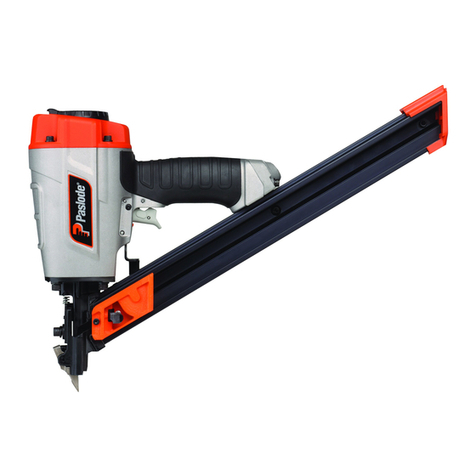
Paslode
Paslode Positive Placement PF150S-PP Operating manual and schematic
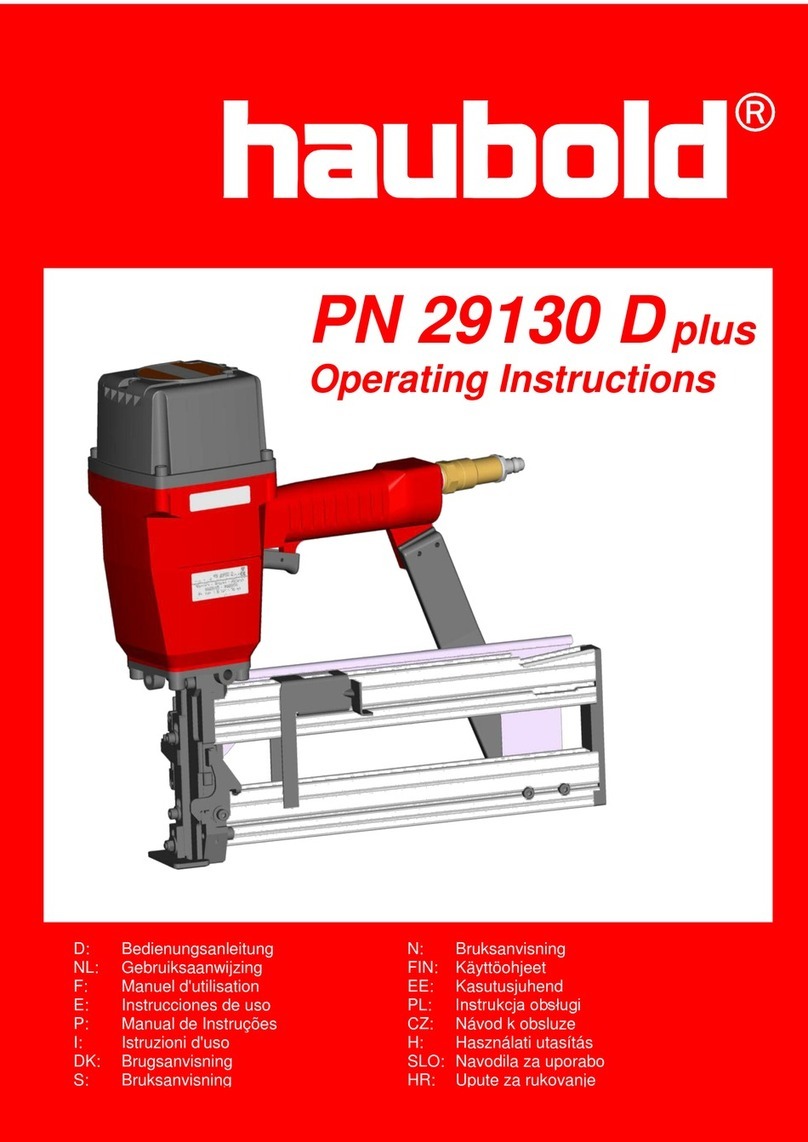
haubold
haubold 29130 D plus operating instructions
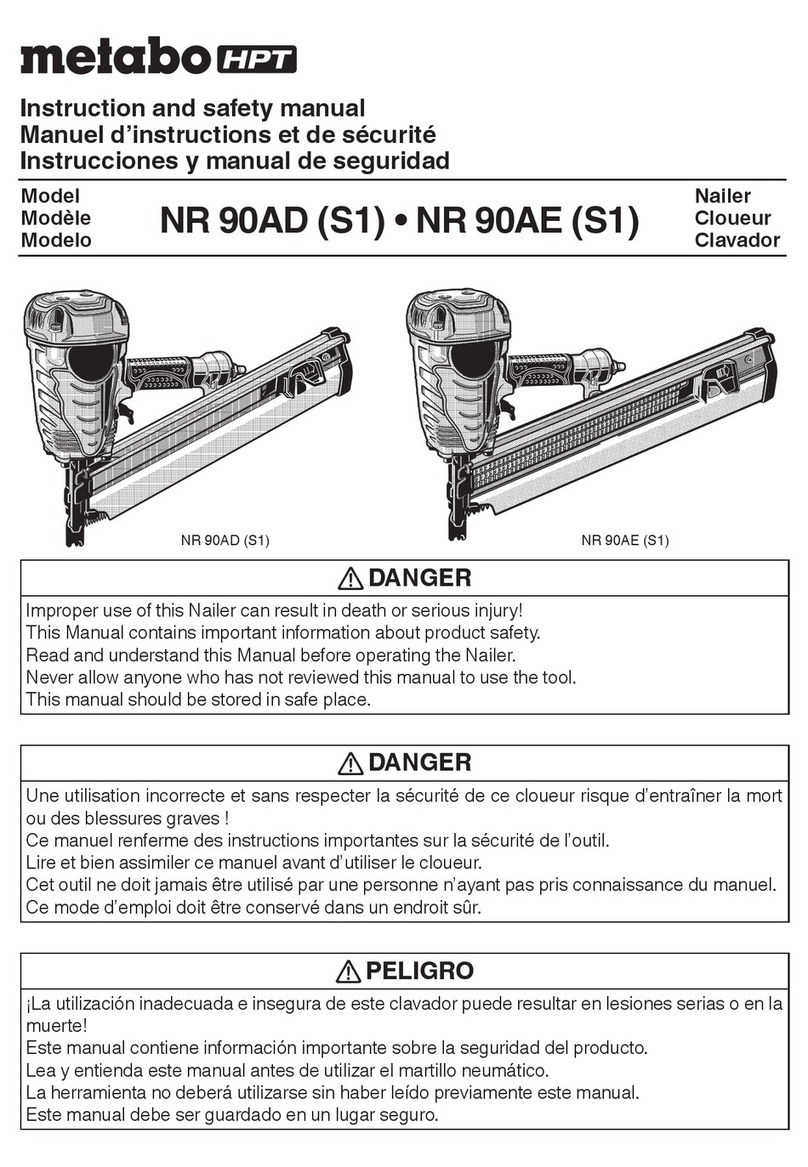
Metabo HPT
Metabo HPT NR 90AD Instruction and safety manual

Bosch
Bosch 0 607 161 100 Original instructions
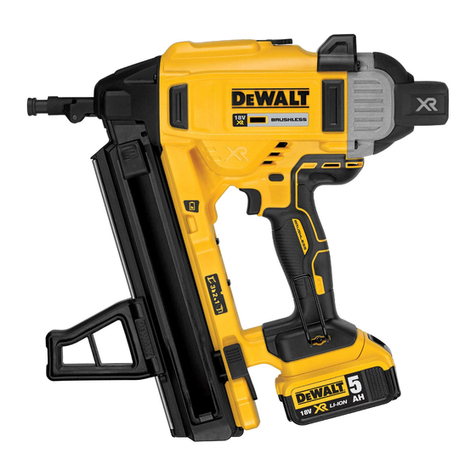
DeWalt
DeWalt DCN890 Original instructions
